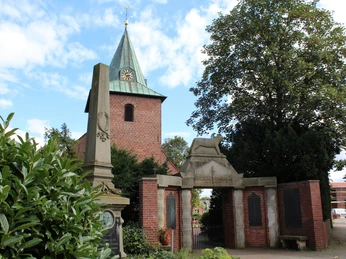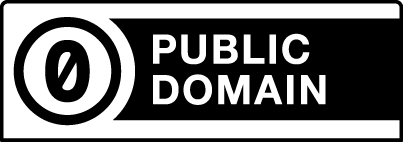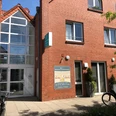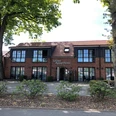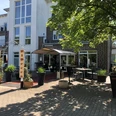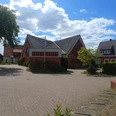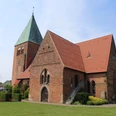- Photos & Map
How would you like to arrive?
- Call
- Description
- Good to know
- Nearby
St. Mary's Church in the district of Leeste is the spiritual center of the Protestant-Lutheran parish of Leeste, which is made up of the Weyher districts of Angelse, Erichshof, Hagen, Hörden, Leeste and Melchiorshausen.
After the medieval nave, which was extended in the 16th century, was demolished in 1776 or 1777, a neoclassical hall building was erected in its place. The brick building with its five window axes was completed by 1780. Work on the interior, however, was not completed until two years later. The highlight was the installation of the pulpit altar from the workshop of the wood and stone sculptor Johann Friedrich Blasius Zisenis in Hanover in 1782.
The oldest bell, weighing more than 900 kilograms, dates back to pre-Reformation times. It was cast in 1516 and bears the name of Our Lady. The name "Marienkirche", which became common in the 1950s and 60s, goes back to the name of the bell; the name of the medieval patron saint is not known.
The history of Leeste's Marienkirche at a glance:
2nd half of the First mention of the settlement of Leeste In the 1180s, it refers to a Meier or main courtyard ("curtis") of the chapter of Bremen's
St. Ansgari church. Ansgari church.
1507 Although there must have been a place of worship on the site of the Marienkirche for centuries, the "kerken to leeste" first appears in an old-style document from the Heiligenrode monastery dated January 12, 1507. The church in Leeste was under the jurisdiction of the cathedral provost of Bremen. There is no mention of a patrocinium.
The large bell is recast in 1516. It bears the following inscription in Middle Low German: "wen ick maria werde gheluth gades denst dat bedut sick manich sunder moge bekere[n] gade to laue und marien to eren" ("If I, Mary, am rung, that means worship [and] many a sinner may convert to praise God and honor Mary"). It has the note "f" and weighs over 900 kg. The lower diameter and height are 1.18 m.
Around 1530 The Reformation, promoted by the sovereign, Count Jobst II von Hoyamassiv, probably reached the parish of Leeste between 1525 and 1530. The first Lutheran clergyman was Hermann Rischmann or Rishelmann. It is possible that he had already worked as a Catholic priest in the parish beforehand.
2nd half of the 16th century According to a report from 1774, the medieval nave had been extended 200 years earlier by a "wing of wood towards the north" (by a half-timbered extension?). In the 18th century it is called the "new church", is just over 7 meters long and a good 6 meters wide. The "old church" covered an area of 21.2 by 6.7 meters.
In 1696, Pastor Johann Friedrich Milde reported that there was no lack of "nefarious sinners" in his parish
district. For example, "Cordt Boße had knocked out his mother's teeth". He had therefore been "locked to the pillory with his left hand" in the churchyard, but without showing the slightest remorse. While still in the pillory, he had loudly threatened that he "wanted to beat his mother even more with his right hand".
1712 The parish of Leeste had a population of 1244. There are 889 people living in rural households alone and 394 people in cottage families.
1774 Master carpenter Johann Christian Timpner from Blender submits plans
and a cost estimate for a new church.
1775 According to the population census, there are 1025 people living in Leeste parish.
1776 On the occasion of the visitation on July 24, a clerk notes: "The church building is in the most dilapidated condition ..." A short time later, the "new" and "old" church are demolished.
1777-1780 The nave is rebuilt, most likely using the designs submitted by master carpenter Timpner in 1774. The result is a classicist hall building with five window axes. Both the side portals and the window reveals are made of Barsinghausen sandstone. A wooden barrel vault extends over the middle rows of seats and the choir.
1782 The pulpit altar from the workshop of the wood and stone sculptor Johann Friedrich Blasius Zisenis in Hanover is installed.
1783 On 30 May, the day after the introduction of the new church law, the church is opened. May, one day after the installation of the pastor Johann
Justus Holzmann, the completed preaching house is inaugurated.
1785 On July 14, Leest schoolteacher and sexton Georg Wilhelm Neumann notes "that our tower is beginning to become so damaged that one ... cannot safely pass by in strong winds". The tower, covered with roof tiles, was then almost completely demolished between 1785 and 1790. The old walls remain up to a height of about six meters.
In 1811, Leeste receives a new small bell. Its diameter is 110 cm, its height also 110 cm. According to an inventory compiled in 1892, it bears the following inscriptions: "Herr J.G. Conrad Meyer Superintendent zu Weihe. August Wilhelm Stelling bailiff of Sycke. Christian Wilhelm Raven Pastor of Leeste, Georg Hermann Wilhelm Neumann, Cantor" - "Harm Vos and Claus Schulte, church judges. Johann Meyer or Bollmann, master farmer F. Holdhausen and C. Bosse jurors. Cast by Johann Philipp Bartels in Bremen in 1811." The bell had to be delivered for military purposes in 1916.
1852 Despite a wave of emigration in the 1840s, the parish of Leeste had almost 2750 members. The wooden shingle roof covering of the spire has become damaged. The tower is now given a slate roof, which is completed in November. The work is carried out by the Bremen slate tiler Wachsmuth. The knob and cock are regilded.
1869/70 In the summer of 1869, the church is thoroughly renovated. Apparently the galleries, which had already been installed in 1778, were also altered. In the summer of 1870, the building is repainted inside.
1872 January 21: Inauguration of the first Leester church organ. It has 2 manuals, 1 pedal, 10 stops and 3 subsidiary stops. It was manufactured by the company Philipp Furtwängler & Söhne in Elze.
1924 August 25: The small church bell, a gift from the "Widow Steinhard and her sister-in-law", is recast and replaces the bell from 1811 that was confiscated during the First World War.
1925 June 16: 3809 members of the Evangelical Lutheran Church are registered in the parish of Leeste. The population of the political parishes of Erichshof and Leeste (they are merged in 1928) is 3945.
1942 On March 23, the bell donated in 1924 has to be delivered for wartime economic reasons. It is transported to the Wilhelmsburg tin works.
1945 In mid-April, there is fierce fighting on the ground in Leeste between German and British units advancing on Bremen. The church is damaged by artillery and tank fire. - The damage to the sacristy and the roof of the nave can be repaired in 1946. The repair of the church tower, the east side of which was badly damaged during the fighting, follows in 1948.
1954 Harvest festival: Rededication of the church and cemetery chapel, which has been renovated in five construction phases since 1946.
1956 January 1: The political community of Leeste has 6729 inhabitants, including 2157 refugees, displaced persons and evacuees. A total of 6476 residents belong to the Evangelical Lutheran Church. During the course of the year, the organ of St. Mary's Church is renovated by the Wilhelmshaven organ builder Alfred Führer. Three new stops are installed.
1957 On March 1, a second pastorate is established in the parish of Leeste, but not filled until the end of 1959. This pastoral district includes Leeste and Hagen, while the first pastorate is assigned to the districts of Angelse, Erichshof, Hörden and Melchiorshausen.
1957 2nd Advent: Consecration of the new small bell, cast on November 16 by the Otto bell foundry in Hemelingen. It weighs 720 kg and is tuned in "g". The diameter and height are 1.05 m. Meta Rumpsfeld, née Holdhausen from Leeste, donated it in memory of her deceased husband.
1964 The consequences of storm damage in 1958 made it necessary to replace the roof covering of the spire. As the slate roof, which was built in 1852, had already been re-roofed twice, the decision was made to re-cover it with copper. The Turm-Linde company from Berlin carries out the work.
1968 August 2: Second rededication of the newly renovated Marienkirche. In two construction phases since 1967, the floors, pews, hot water heating, lamps and organ motor have been renewed, the entrance area in the tower has been redesigned and the moisture has been removed from the walls by draining. The interior of the church also received a new coat of paint.
Before 1976 St. Mary's Church receives a new baptismal font.
2009 August 24: Two new bells are cast by the Albert Bachert company in Karlsruhe. The smaller bell weighs 700 kg, has a diameter of 1.098 m, is tuned in "g" and bears the inscription "To the glory of our God - a blessing to us humans. Leeste anno domini 2009." It replaces the bell donated by Meta Rumpsfeld in 1957, which had cracked due to material fatigue. Thanks to the generous donation of the Leeste farmer Karl-Heinz Ahrens and his family, it does not have to be melted down and is placed in front of the church tower. The larger Domenica weighs 1,700 kg and is 1.479 m in diameter. It rings the note "d". Psalm 105:1 was chosen for its inscription: "Give thanks to the LORD and call on his name; proclaim his deeds among the nations. Leeste anno domini 2009."
2013 June 17: The Evangelical Lutheran Marien-Kirchengemeinde Leeste has 6006 members. Repair work is carried out on the church tower in May and June. The clock faces and the weathercock are replaced and the tower knob is restored. The documents in the sphere dating from 1852, 1948 and 1964 are removed and replaced with copies, while the originals are placed in the parish archives.
After the medieval nave, which was extended in the 16th century, was demolished in 1776 or 1777, a neoclassical hall building was erected in its place. The brick building with its five window axes was completed by 1780. Work on the interior, however, was not completed until two years later. The highlight was the installation of the pulpit altar from the workshop of the wood and stone sculptor Johann Friedrich Blasius Zisenis in Hanover in 1782.
The oldest bell, weighing more than 900 kilograms, dates back to pre-Reformation times. It was cast in 1516 and bears the name of Our Lady. The name "Marienkirche", which became common in the 1950s and 60s, goes back to the name of the bell; the name of the medieval patron saint is not known.
The history of Leeste's Marienkirche at a glance:
2nd half of the First mention of the settlement of Leeste In the 1180s, it refers to a Meier or main courtyard ("curtis") of the chapter of Bremen's
St. Ansgari church. Ansgari church.
1507 Although there must have been a place of worship on the site of the Marienkirche for centuries, the "kerken to leeste" first appears in an old-style document from the Heiligenrode monastery dated January 12, 1507. The church in Leeste was under the jurisdiction of the cathedral provost of Bremen. There is no mention of a patrocinium.
The large bell is recast in 1516. It bears the following inscription in Middle Low German: "wen ick maria werde gheluth gades denst dat bedut sick manich sunder moge bekere[n] gade to laue und marien to eren" ("If I, Mary, am rung, that means worship [and] many a sinner may convert to praise God and honor Mary"). It has the note "f" and weighs over 900 kg. The lower diameter and height are 1.18 m.
Around 1530 The Reformation, promoted by the sovereign, Count Jobst II von Hoyamassiv, probably reached the parish of Leeste between 1525 and 1530. The first Lutheran clergyman was Hermann Rischmann or Rishelmann. It is possible that he had already worked as a Catholic priest in the parish beforehand.
2nd half of the 16th century According to a report from 1774, the medieval nave had been extended 200 years earlier by a "wing of wood towards the north" (by a half-timbered extension?). In the 18th century it is called the "new church", is just over 7 meters long and a good 6 meters wide. The "old church" covered an area of 21.2 by 6.7 meters.
In 1696, Pastor Johann Friedrich Milde reported that there was no lack of "nefarious sinners" in his parish
district. For example, "Cordt Boße had knocked out his mother's teeth". He had therefore been "locked to the pillory with his left hand" in the churchyard, but without showing the slightest remorse. While still in the pillory, he had loudly threatened that he "wanted to beat his mother even more with his right hand".
1712 The parish of Leeste had a population of 1244. There are 889 people living in rural households alone and 394 people in cottage families.
1774 Master carpenter Johann Christian Timpner from Blender submits plans
and a cost estimate for a new church.
1775 According to the population census, there are 1025 people living in Leeste parish.
1776 On the occasion of the visitation on July 24, a clerk notes: "The church building is in the most dilapidated condition ..." A short time later, the "new" and "old" church are demolished.
1777-1780 The nave is rebuilt, most likely using the designs submitted by master carpenter Timpner in 1774. The result is a classicist hall building with five window axes. Both the side portals and the window reveals are made of Barsinghausen sandstone. A wooden barrel vault extends over the middle rows of seats and the choir.
1782 The pulpit altar from the workshop of the wood and stone sculptor Johann Friedrich Blasius Zisenis in Hanover is installed.
1783 On 30 May, the day after the introduction of the new church law, the church is opened. May, one day after the installation of the pastor Johann
Justus Holzmann, the completed preaching house is inaugurated.
1785 On July 14, Leest schoolteacher and sexton Georg Wilhelm Neumann notes "that our tower is beginning to become so damaged that one ... cannot safely pass by in strong winds". The tower, covered with roof tiles, was then almost completely demolished between 1785 and 1790. The old walls remain up to a height of about six meters.
In 1811, Leeste receives a new small bell. Its diameter is 110 cm, its height also 110 cm. According to an inventory compiled in 1892, it bears the following inscriptions: "Herr J.G. Conrad Meyer Superintendent zu Weihe. August Wilhelm Stelling bailiff of Sycke. Christian Wilhelm Raven Pastor of Leeste, Georg Hermann Wilhelm Neumann, Cantor" - "Harm Vos and Claus Schulte, church judges. Johann Meyer or Bollmann, master farmer F. Holdhausen and C. Bosse jurors. Cast by Johann Philipp Bartels in Bremen in 1811." The bell had to be delivered for military purposes in 1916.
1852 Despite a wave of emigration in the 1840s, the parish of Leeste had almost 2750 members. The wooden shingle roof covering of the spire has become damaged. The tower is now given a slate roof, which is completed in November. The work is carried out by the Bremen slate tiler Wachsmuth. The knob and cock are regilded.
1869/70 In the summer of 1869, the church is thoroughly renovated. Apparently the galleries, which had already been installed in 1778, were also altered. In the summer of 1870, the building is repainted inside.
1872 January 21: Inauguration of the first Leester church organ. It has 2 manuals, 1 pedal, 10 stops and 3 subsidiary stops. It was manufactured by the company Philipp Furtwängler & Söhne in Elze.
1924 August 25: The small church bell, a gift from the "Widow Steinhard and her sister-in-law", is recast and replaces the bell from 1811 that was confiscated during the First World War.
1925 June 16: 3809 members of the Evangelical Lutheran Church are registered in the parish of Leeste. The population of the political parishes of Erichshof and Leeste (they are merged in 1928) is 3945.
1942 On March 23, the bell donated in 1924 has to be delivered for wartime economic reasons. It is transported to the Wilhelmsburg tin works.
1945 In mid-April, there is fierce fighting on the ground in Leeste between German and British units advancing on Bremen. The church is damaged by artillery and tank fire. - The damage to the sacristy and the roof of the nave can be repaired in 1946. The repair of the church tower, the east side of which was badly damaged during the fighting, follows in 1948.
1954 Harvest festival: Rededication of the church and cemetery chapel, which has been renovated in five construction phases since 1946.
1956 January 1: The political community of Leeste has 6729 inhabitants, including 2157 refugees, displaced persons and evacuees. A total of 6476 residents belong to the Evangelical Lutheran Church. During the course of the year, the organ of St. Mary's Church is renovated by the Wilhelmshaven organ builder Alfred Führer. Three new stops are installed.
1957 On March 1, a second pastorate is established in the parish of Leeste, but not filled until the end of 1959. This pastoral district includes Leeste and Hagen, while the first pastorate is assigned to the districts of Angelse, Erichshof, Hörden and Melchiorshausen.
1957 2nd Advent: Consecration of the new small bell, cast on November 16 by the Otto bell foundry in Hemelingen. It weighs 720 kg and is tuned in "g". The diameter and height are 1.05 m. Meta Rumpsfeld, née Holdhausen from Leeste, donated it in memory of her deceased husband.
1964 The consequences of storm damage in 1958 made it necessary to replace the roof covering of the spire. As the slate roof, which was built in 1852, had already been re-roofed twice, the decision was made to re-cover it with copper. The Turm-Linde company from Berlin carries out the work.
1968 August 2: Second rededication of the newly renovated Marienkirche. In two construction phases since 1967, the floors, pews, hot water heating, lamps and organ motor have been renewed, the entrance area in the tower has been redesigned and the moisture has been removed from the walls by draining. The interior of the church also received a new coat of paint.
Before 1976 St. Mary's Church receives a new baptismal font.
2009 August 24: Two new bells are cast by the Albert Bachert company in Karlsruhe. The smaller bell weighs 700 kg, has a diameter of 1.098 m, is tuned in "g" and bears the inscription "To the glory of our God - a blessing to us humans. Leeste anno domini 2009." It replaces the bell donated by Meta Rumpsfeld in 1957, which had cracked due to material fatigue. Thanks to the generous donation of the Leeste farmer Karl-Heinz Ahrens and his family, it does not have to be melted down and is placed in front of the church tower. The larger Domenica weighs 1,700 kg and is 1.479 m in diameter. It rings the note "d". Psalm 105:1 was chosen for its inscription: "Give thanks to the LORD and call on his name; proclaim his deeds among the nations. Leeste anno domini 2009."
2013 June 17: The Evangelical Lutheran Marien-Kirchengemeinde Leeste has 6006 members. Repair work is carried out on the church tower in May and June. The clock faces and the weathercock are replaced and the tower knob is restored. The documents in the sphere dating from 1852, 1948 and 1964 are removed and replaced with copies, while the originals are placed in the parish archives.
Good to know
Openings
Author
Mittelweser-Touristik GmbH
Lange Straße 18
31582 Nienburg/Weser
Organization
Mittelweser-Touristik GmbH
License (master data)
Mittelweser-Touristik GmbH
Nearby

